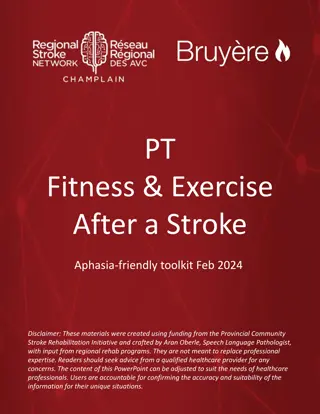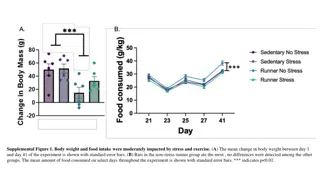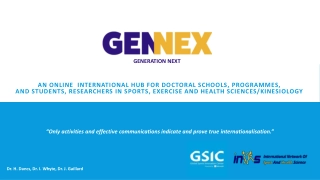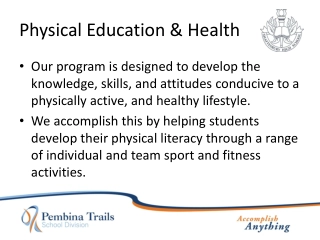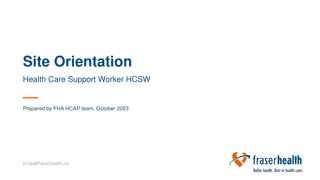Essential Types of Exercise for Lifelong Health & Fitness
Explore the four essential types of exercise - Endurance, Strength, Balance, and Flexibility - and understand their benefits for improving overall health, fitness, and quality of life. Learn how to incorporate these exercises into your routine to enhance heart and lung health, build strength and maintain healthy bones, improve balance and prevent injuries, and enhance flexibility for better range of motion and joint health. Discover tips on setting personal fitness goals and selecting exercises to contribute to your fitness development.
Download Presentation
Please find below an Image/Link to download the presentation.
The content on the website is provided AS IS for your information and personal use only. It may not be sold, licensed, or shared on other websites without obtaining consent from the author. Download presentation by click this link. If you encounter any issues during the download, it is possible that the publisher has removed the file from their server.
Presentation Transcript
Types of Exercise Needed for Lifelong Health & Fitness ESSENTIAL QUESTION: CAN I IDENTIFY AND SELECT EXERCISES TO CONTRIBUTE TO PERSONAL FITNESS DEVELOPMENT? Author: Caitlin Fregelette
Four Types of Exercise for Health, Happiness, Independence, & Quality of Life ENDURANCE STRENGTH BALANCE FLEXIBILITY
Endurance Exercise & Activity Improve heart & lung health Improve fitness, mood, & energy Reduce stress & anxiety Perform day to day tasks with ease Prevent lifestyle diseases Strength Builds & maintains healthy bones, muscles, & joints Live freely & independently in body Improves balance & prevents injury Enhances self-esteem & creates positive body image
Balance Exercise & Activity Engages core & improves posture Prevents falls & injuries Strengthens stabilizer muscles Improves joint stability Flexibility Eases muscle aches & pains Allows body to maintain full range of motion Improves posture & joint health Enhances athletic performance Relieves tension & stress
Explain one benefit from each type of exercise that is relevant to you and your future goals. THINK, PAIR, SHARE
Endurance Build up to at least 150 minutes of physical activity a week at an intensity level that increases heart rate, respiration, and perspiration. 150 mins Move 5 days a week for at least 30 minutes of endurance-based activities like walking, cycling, jumping rope, active sports, dance, boxing, calisthenics, plyometrics, group fitness classes. 5x30 Break activity into 3 sessions of 10-minute movement snacks throughout the day to reach this goal & avoid sitting for long periods of time. 3x10
Endurance Do a proper warm-up with dynamic stretches & movement prior to endurance exercises and cool down to safely bring the heart rate back to a normal state. Use the talk test to assess exercise intensity. If you can hold a conversation, it s moderate activity. If you can only say a couple words, it s vigorous activity.
Consider different physical activities youve participated in throughout your lifetime. 1. Describe a physical activity you participated in that you could have a conversation with another person. 2. Describe a physical activity you participated in that you could barely say one or two words. THINK, PAIR, SHARE
Strength Strength exercises include weightlifting, plyometric training, using a resistance band, or performing body weight exercises such as push-ups, squats, dips, lunges, planks, and bicycle crunches. Strength train at least 2-3 days per week targeting all major muscle groups on nonconsecutive days allowing for rest and recovery between training sessions. Use proper form for safety and injury prevention!
How can you incorporate 2-3 days of muscular strength exercises into your weekly routine? THINK, PAIR, SHARE
Balance Engage your core by closing the ribs, tucking the tailbone under, and embracing the abdomen as if it s about to get hit. Perform exercises that create an imbalance to engage stabilizer muscles & improve joint stability. Perform strength exercises standing on one leg or doing unilateral work like bird-dog, step ups, or single leg deadlift. Brush your teeth or load/unload the dishwasher while balancing on one leg.
Describe effective ways a person could incorporate more than one type of exercise into a single movement session. THINK, PAIR, SHARE
Flexibility A healthy level of flexibility makes it easier to complete everyday tasks like reaching down to tie shoes or bending down to pick something up. Participating regularly in flexibility training improves posture, athletic performance, joint health while relieving tension and stress in the body. Static stretch when muscles are warm, preferably after physical activity. Use the breath to provide oxygen to the muscles for a deeper stretch. Stretch after endurance or strength exercises to release tension in the muscles and reduce DOMS. Stretch to a point of mild tension, never pain!
Flexibility Make it a habit to stretch all major muscle groups for 10-15 minutes daily holding each stretch for 10-20 seconds. Start the day with a morning flow or stretch before bed to calm the body and mind for a restful sleep. Play calming music, dim the lights, and pay attention to your breathing rate to rest, recover, and recharge. Improve flexibility through dynamic activities like yoga, Pilates, barre, dance, gymnastics, wrestling, and martial arts.
Where do you feel tightness, pain, or tension in your body? What exercises can you perform regularly to relieve the stress in your muscles and joints? THINK, PAIR, SHARE
Examples of Each Type of Exercise Run, jog, hike, walk, active sports, dance, box, swim, cycle, jump rope, row, calisthenics, agility training Endurance Weightlifting, HIIT workouts, yoga, Barre, plyometric training, Pilates, gymnastics, dance Strength Yoga, dance, martial arts, gymnastics, wrestling, unilateral weightlifting or body weight training Balance Flexibility Stretching, yoga, dance, martial arts, wrestling,
Move for Health and Wellness It s important to incorporate all four types of exercise into a workout plan: endurance, strength, balance, and flexibility. Each one has different benefits for short- and long-term health, fitness, independence, and quality of life. Variety in movement helps reduce boredom and risk of injury.
FITNESS FOR LIFE Start young by building the habit now! Develop an exercise routine that is meaningful, challenging, and fun for you. Include activities that improve personal fitness levels and are specific to your needs. Make it social by participating with others for more enjoyment and accountability. Adopt habits that enhance health for a long, happy, productive, successful life.
What types of physical activities do you enjoy doing with others? What makes it more enjoyable? THINK, PAIR, SHARE
TYPES OF EXERCISE LEARNING ASSESSMENT


